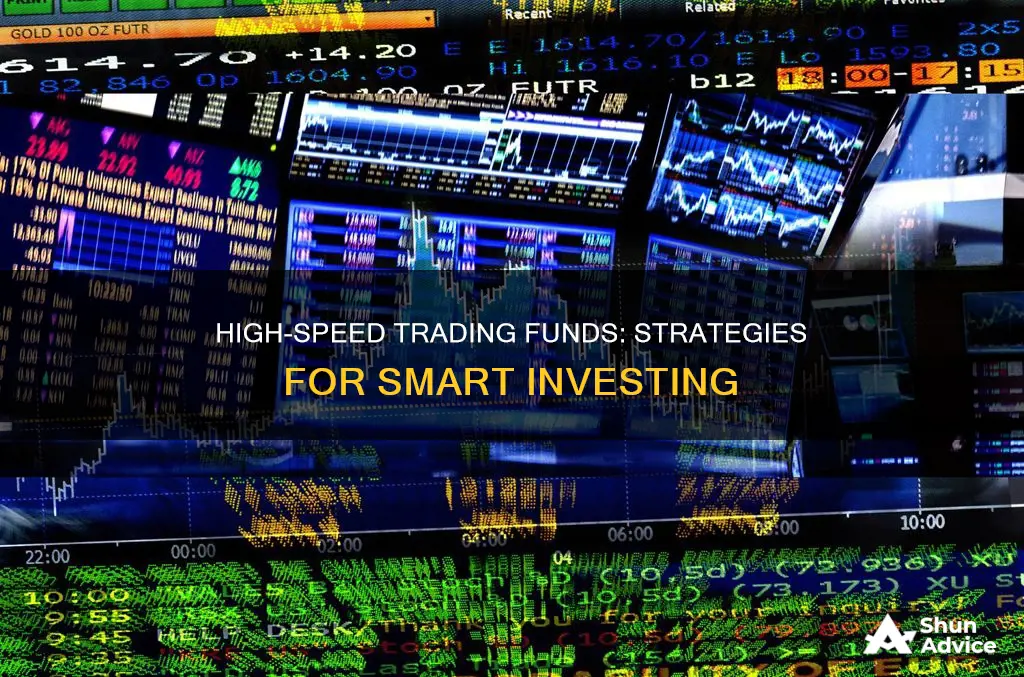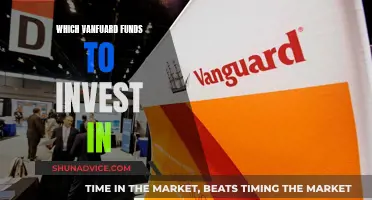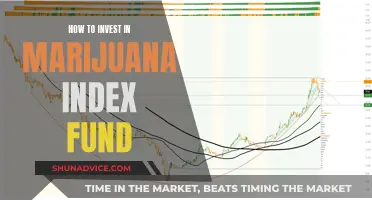
High-frequency trading (HFT) is a controversial topic in the world of finance, often associated with large investment banks, hedge funds, and institutional investors. It involves using powerful computers and complex algorithms to execute a large number of orders within seconds, aiming to capitalize on emerging trends and minute market discrepancies. While HFT has been criticized for giving an unfair advantage to large firms, it also improves market liquidity and enables faster execution of trades. This paragraph introduces the topic of investing in high-speed trading funds, a strategy that has both proponents and critics due to its complex nature and potential impact on financial markets.
| Characteristics | Values |
|---|---|
| Definition | High-frequency trading (HFT) |
| Description | A trading method that uses powerful computer programs to transact a large number of orders in fractions of a second |
| Speed | High-frequency trading is fast, sometimes as quick as 10 milliseconds |
| Data | HFT uses large amounts of data to process and analyse |
| Risk | HFT is risky, with potential for large losses in seconds |
| Profitability | HFT has the potential for high profitability due to the large volume of trades |
| Competition | HFT firms compete with other HFTs rather than long-term investors |
| Regulation | HFT is legal and regulated by the SEC, but certain practices within it are illegal |
| Advantages | HFT increases liquidity, narrows bid-ask spreads, and lowers volatility |
| Disadvantages | HFT has been criticised for its potential to cause market volatility and give an unfair advantage to large companies |
| Examples | Tower Research Capital, Citadel LLC, Virtu Financial |
What You'll Learn

High-frequency trading (HFT) strategies
High-frequency trading (HFT) is a complex and controversial strategy that involves powerful computer algorithms executing a high volume of trades in extremely short time frames, often within fractions of a second. The strategy is characterised by high speeds, high turnover rates, and high order-to-trade ratios, aiming to capitalise on small, short-lived profitable opportunities in the markets. Here are some of the key HFT strategies:
Market Making
Market making involves placing both buy and sell limit orders to profit from the bid-ask spread. Market makers act as counterparties, providing liquidity to the market and earning a fraction of a cent for every trade. They set their sell prices slightly above the current market price and their buy prices slightly below.
Event Arbitrage
Event arbitrage takes advantage of predictable short-term responses in certain securities following economic, political, or natural events. High-frequency traders use their advanced technology to identify and act on these arbitrage opportunities before other market players.
Index Arbitrage
Index arbitrage arises when index tracker funds need to buy and sell large volumes of securities to rebalance their portfolios. HFT firms with access to this information can front-run the index funds, taking advantage of the price discrepancies that arise from these large-volume trades.
Statistical Arbitrage
Statistical arbitrage involves exploiting temporary price discrepancies between related currency pairs or different exchanges/asset classes. This strategy relies on advanced statistical modelling and historical data analysis to identify and act on pricing anomalies.
Latency Arbitrage
Latency arbitrage focuses on reducing the latency or delay in transactions. By utilising high-speed HFT systems, firms can take advantage of millisecond price discrepancies, profiting from minute differences in transaction speeds.
News-based Trading
News-based trading involves reacting swiftly to market-moving events and news releases to capitalise on short-term price movements. This strategy requires access to high-quality, low-latency data feeds and automated systems that can process and act on news information in real time.
Scalping
Scalping is a potentially more affordable HFT strategy, as it has lower technology and infrastructure requirements. It involves executing a high number of rapid trades to profit from small price changes within short time frames, typically seconds or minutes.
Overall, HFT strategies demand substantial investments in technology and market access, advanced data analysis skills, and a strong understanding of market dynamics.
Utility Index Funds: When to Invest for Maximum Returns
You may want to see also

HFT advantages and disadvantages
High-Frequency Trading (HFT) Advantages and Disadvantages
High-frequency trading (HFT) is a strategy that employs powerful computers and complex algorithms to execute a high volume of trades within milliseconds. While it offers significant advantages, there are also drawbacks and risks associated with this trading approach.
Advantages:
- Speed and Efficiency: HFT algorithms execute trades at extremely high speeds, allowing traders to capitalise on small market fluctuations and potentially leading to higher profits, especially when trading large volumes.
- Liquidity Provision: HFT firms provide liquidity to the market by frequently entering and exiting positions, ensuring a constant pool of buyers and sellers. This reduces spreads and enhances market efficiency, benefiting all traders.
- Enhanced Risk Management: HFT algorithms are equipped with advanced risk management features, enabling automatic loss-cutting, position adjustments, and portfolio diversification in real time, thus helping brokers mitigate risks effectively.
- Data Analysis and Pattern Recognition: HFT systems can analyse vast amounts of data and identify subtle patterns, uncovering market opportunities that human traders might miss.
Disadvantages:
- Increased Market Volatility: Critics argue that HFT can amplify market volatility as algorithms rapidly react to price changes, potentially triggering a cascade of automated trading actions. This volatility can make it challenging for traders to predict market movements and may lead to unexpected losses.
- Market Manipulation Concerns: There have been accusations of market manipulation by HFT firms, as the rapid execution of orders can create the appearance of trends, misleading other traders and influencing price movements.
- High Infrastructure Costs: Implementing HFT strategies requires substantial investments in cutting-edge technology and infrastructure, which may be prohibitive for smaller brokers.
- Regulatory Scrutiny and Ethical Concerns: The rise of HFT has led to increased regulatory scrutiny and complex compliance requirements. Additionally, there are ethical debates around HFT, with critics arguing that it gives an unfair advantage to large firms and unbalances the playing field.
- Unfair Advantage for Technologically Advanced Traders: HFT has been criticised for giving an edge to traders with access to superior technology and information, making it challenging for long-term investors to succeed.
- Ghost Liquidity: Opponents of HFT argue that the liquidity it provides is not "real" as securities are held for only a few seconds. Regular investors often find that the liquidity has disappeared by the time they place an order.
- Risk of Significant Losses: Due to the high-frequency nature of trades, a single bad trade or flawed algorithm could result in substantial losses within seconds, potentially spooking other traders and causing a ripple effect across markets.
Mutual Funds Backing AMD: Who's Investing in the Tech Giant?
You may want to see also

HFT regulation and legality
High-frequency trading (HFT) is a highly debated topic among economists due to its potential impact on financial markets. Critics have called for aggressive regulation to address concerns such as unfair advantages over retail investors and sudden major market moves. However, others argue that HFT improves market efficiency and liquidity, making stringent regulation unnecessary.
One of the key advantages of HFT is its ability to enhance liquidity in financial markets. The U.S. Securities and Exchange Commission (SEC) has found that HFT increases price accuracy and lowers transaction costs. The competitive nature of HFT has also contributed to narrower bid-ask spreads, improving the cost structure for investors.
While there are risks associated with HFT, some argue that implementing regulations to curb or eliminate it could negatively affect the efficiency, liquidity, and stability of secondary markets. For example, imposing financial transaction taxes (FTTs) on HFT could limit market activity and drive investors towards less regulated emerging markets.
Currently, FINRA member firms that engage in algorithmic strategies, including HFT, are subject to SEC and FINRA rules such as FINRA Rule 3110 (Supervision). These rules include practices such as general risk assessment and response, software testing and system validation, and ensuring effective communication between compliance staff and algorithmic strategy development staff.
Some specific oversight areas for HFT have been implemented, such as the banning of "spoofing," a tactic used to influence competitors with fake trades, following the Dodd-Frank Act. While there are ongoing discussions and proposals regarding the regulation of HFT, the impact of any future regulations on the efficiency and stability of financial markets will be carefully considered.
Funding Investments: Strategies for Covering Total Amounts Received
You may want to see also

HFT firms and their operations
High-frequency trading (HFT) firms have been around for a couple of decades and are an important part of investment markets. They account for about 50% of equities trading volume across the U.S. and Europe. HFT firms can be divided into three types: independents, subsidiaries of broker-dealer firms, and hedge funds.
Independents are the most common and biggest form of HFT firm. They are proprietary trading firms that execute trades with their own money rather than that of their clients. Some of the notable names in this category include Citadel, IMC, Jump Trading, and Virtu Financial.
The second type of HFT firm is a subsidiary of a broker-dealer firm. Many of these firms have proprietary trading desks, where HFT is performed, separate from the work they do for their regular, external clients. Examples include BNP Paribas, Credit Suisse, Deutsche Bank, Goldman Sachs, and Morgan Stanley.
Finally, HFT firms also operate as hedge funds, focusing on gains from pricing inefficiencies across securities and other asset categories using arbitrage.
HFT firms rely on powerful computers and complex algorithms to execute a large number of orders within seconds. They scan multiple markets and exchanges, allowing them to spot emerging trends and transact millions of orders at extremely high speeds. This gives them an advantage over competitors and the ability to generate significant profits.
While HFT firms have been criticized for giving large companies an unfair advantage and increasing market volatility, they also provide benefits such as improved liquidity and the elimination of small bid-ask spreads.
Hedge Fund Investment: A Guide for Indians
You may want to see also

HFT's impact on markets
High-frequency trading (HFT) has a significant impact on modern securities markets. HFT accounts for a large share of the market, with around 35% of the total equity trading volume in Europe and about 50% in the US. The speed and volume of HFT transactions allow large companies to gain an advantage over smaller investors.
Impact on Liquidity
HFT adds liquidity to the markets by executing a large number of trades in a short amount of time. This results in reduced bid-ask spreads, which are a marker of market liquidity. HFT firms are willing to take the other side of trades and wait for them to be filled, rather than needing immediate execution.
However, critics argue that HFT only provides "ghost liquidity" that disappears within seconds, making it impossible for other traders to take advantage of it. A study on the impact of an HFT interruption on the Deutsche Börse exchange found that liquidity significantly decreased when HFT was not available.
Impact on Volatility
The speed of HFT transactions can also lead to increased market volatility. With trades being executed in a matter of seconds, a single bad trade or flawed algorithm could result in significant losses within a short period. This was evident in the 2010 "Flash Crash", where the S&P 500 dropped dramatically in a matter of minutes, with critics arguing that HFT firms exacerbated the selloff.
On the other hand, HFT firms can also help mitigate price fluctuations by employing market-making strategies. A study by Brogaard et al. (2018) found that HFT firms initially trade in the opposite direction of extreme price movements, but they can also accelerate these movements if they persist.
Other Impacts
HFT firms can also engage in illegal practices such as front-running and spoofing. Front-running involves using non-public information to anticipate and profit from price movements, while spoofing involves placing and then cancelling market orders to create price movements.
HFT has also been criticised for removing human decision-making from the trading process, with algorithms making rapid decisions that can lead to flash highs and troughs in the market.
Tips Mutual Funds: When to Invest for Maximum Returns
You may want to see also
Frequently asked questions
High-speed trading, or high-frequency trading (HFT), is a type of algorithmic trading that uses powerful computers to execute a large number of orders at extremely high speeds, often within fractions of a second. HFT firms use complex algorithms and ultra-fast connections to analyse markets, identify trends, and make trades.
High-speed trading firms use advanced computer algorithms and ultra-fast connections to analyse market data and execute trades at extremely high speeds. They employ various strategies, including arbitrage, market-making, and directional trading, to capitalise on short-term market opportunities.
Some potential advantages of investing in high-speed trading funds include increased liquidity, improved market efficiency, and reduced bid-ask spreads. However, critics argue that high-speed trading can lead to increased market volatility and provide an unfair advantage to large firms over smaller investors. Additionally, the complex and risky nature of high-speed trading strategies may result in significant losses.
To invest in high-speed trading funds, you would typically need to contact a firm specialising in this type of trading. These firms may include independent proprietary trading firms, subsidiaries of broker-dealer firms, or hedge funds. It is important to carefully evaluate the risks and potential benefits before investing in high-speed trading funds.







